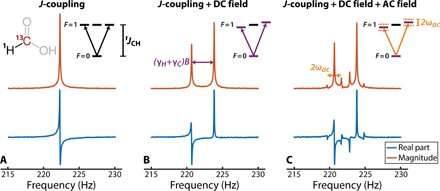Placing another piece in the dark matter puzzle

Very little is known about the exact nature of dark matter. Currently, some of the most promising dark matter candidates are extremely light bosonic particles such as axions, axion-like particles or even dark photons. "These can also be regarded as a classical field oscillating at a certain frequency. But we can't yet put a figure on this frequency—and therefore the mass of the particles," explains Professor Dmitry Budker. "That is why in the CASPEr research program, we are systematically investigating different frequency ranges looking for hints of dark matter."
Budker's group is searching for dark matter through the Cosmic Axion Spin Precession Experiment (CASPEr). The CASPEr group conducts their experiments at the PRISMA+ Cluster of Excellence at Johannes Gutenberg University Mainz (JGU) and the Helmholtz Institute Mainz (HIM). CASPEr is an international research program that uses nuclear magnetic resonance techniques to identify and analyze dark matter.
The CASPEr team is developing special nuclear magnetic resonance (NMR) techniques, each targeted at a specific frequency range and therefore at a specific range of dark-matter particle masses. NMR generally relies on the fact that nuclear spins react to magnetic fields oscillating at a specific resonance frequency. The resonance frequency is tuned via a second, usually static magnetic field. The fundamental idea of the CASPEr research program is that a dark matter field can influence the nuclear spins in the same way. As the Earth moves through this field, nuclear spins behave as if they would experience an oscillating magnetic field, thus generating a dark matter induced NMR spectrum.
In the current work, first author Antoine Garcon and his colleagues used a more exotic technique: zero-to-ultralow-field (ZULF) NMR. "ZULF NMR provides a regime where nuclear spins interact more strongly with each other than they do with an external magnetic field," says corresponding author Dr. John W. Blanchard. "In order to make the spins sensitive to dark matter, we only have to apply a very small external magnetic field, which is much easier to stabilize."
Furthermore, for the first time the researchers examined ZULF NMR spectra of 13C-formic acid with respect to dark-matter-induced sidebands, employing a new analysis scheme to coherently average sidebands of arbitrary frequency over multiple measurements.
This particular form of sideband analysis enabled the scientists to search for dark matter in a new frequency range. No dark matter signal was detected, as the CASPEr team reports in the latest edition of Science Advances, allowing the authors to rule out ultralight dark matter with couplings above a particular threshold. At the same time, these results provide another piece of the dark matter puzzle and complement previous results from the CASPEr program reported in June, when the scientists explored even lower frequencies using another specialized NMR method called comagnetometry.
"Like a jigsaw puzzle, we combine various pieces within the CASPEr program to further narrow down the scope of the dark matter search," asserts Dmitry Budker.
John Blanchard adds, "This is just the first step. We are currently implementing several very promising modifications to increase our experiment's sensitivity."
More information: Antoine Garcon, et al. Constraints on bosonic dark matter from ultralow-field nuclear magnetic resonance Science Advances 25 Oct 2019: Vol. 5, no. 10, eaax4539. DOI: 10.1126/sciadv.aax4539
Journal information: Science Advances
Provided by Universitaet Mainz




















